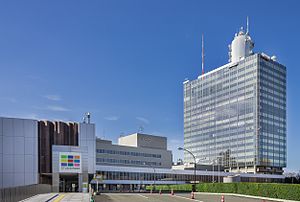
Back هيئة الإذاعة اليابانية Arabic NHK Azerbaijani NHK Bulgarian এনএইচকে Bengali/Bangla NHK Catalan ئێن ئێچ کەی CKB NHK Czech NHK Danish NHK German NHK Greek
You can help expand this article with text translated from the corresponding article in Japanese. (February 2024) Click [show] for important translation instructions.
|
 Logo since March 2020 | |
 NHK Broadcasting Center (headquarters) | |
| Type | Radio, terrestrial television and satellite television broadcaster |
|---|---|
| Branding | NHK |
| Country | Japan |
| Availability | Nationwide and Worldwide |
| Founded | Tokyo Broadcasting Station founded 29 November 1924; merged into Japan Broadcasting Corporation on 6 August 1926 |
| Motto | "まっすぐ、真剣。" ("Honest, seriousness")[1] |
| Headquarters | NHK Broadcasting Center, Shibuya, Tokyo, Japan (35°39′54″N 139°41′45″E / 35.66500°N 139.69583°E) |
Broadcast area | Japan |
| Owner | Government of Japan (statutory corporation chartered under the Broadcasting Act of 1950) |
Key people |
|
Launch date | March 1925 (radio) November 1950 (February 1953) (television) |
Former names | Tokyo/Osaka/Nagoya Broadcasting Station (1925–1926) |
Picture format | 1080i (HDTV) 2160p 4K UHD (NHK BS Premium 4K) 4320p 8K UHD (NHK BS8K) |
Callsign meaning | Nippon Hōsō Kyōkai |
Official website | nhk.or.jp |
The Japan Broadcasting Corporation[2] (Japanese: 日本放送協会, Hepburn: Nippon Hōsō Kyōkai), also known as NHK, is a Japanese public broadcaster.[3] NHK, which has always been known by this romanized initialism in Japanese,[4][a] is a statutory corporation funded by viewers' payments of a television license fee.
NHK operates two terrestrial television channels (NHK General TV and NHK Educational TV), three satellite television channels (NHK BS; as well as two ultra-high-definition television channels, NHK BS Premium 4K and NHK BS8K), and three radio networks (NHK Radio 1, NHK Radio 2, and NHK FM).
NHK also provides an international broadcasting service, known as NHK World-Japan. NHK World-Japan is composed of NHK World TV, NHK World Premium, and the shortwave radio service Radio Japan (RJ). World Radio Japan also makes some of its programs available on the Internet.
NHK was the first broadcaster in the world to broadcast in high-definition (using multiple sub-Nyquist sampling encoding, also known as Hi-Vision) and in 8K.[5]
- ^ "日本放送協会平成17年度業務報告書]" [NHK Business Report 2005] (PDF). p. 42. Archived (PDF) from the original on 14 November 2006.
- ^ NHKの概要
- ^ "NHK: Profile". NHK. Archived from the original on 14 May 2008.
- ^ Sidensticker, Edward (1990). Tokyo Rising: The City Since the Great Earthquake. p. 67.
- ^ "The history of Super Hi-Vision | 8K Super Hi-Vision". NHK. Archived from the original on 13 April 2023.
Cite error: There are <ref group=lower-alpha> tags or {{efn}} templates on this page, but the references will not show without a {{reflist|group=lower-alpha}} template or {{notelist}} template (see the help page).
© MMXXIII Rich X Search. We shall prevail. All rights reserved. Rich X Search